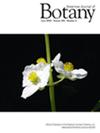Undescribed species diversity in Brewer's jewelflower illuminates potential mechanisms of diversification associated with serpentine endemism
Abstract
Premise
Documenting species-level diversity is a fundamental goal of biology, yet undescribed species remain hidden even in well-studied groups. Inaccurate delimitation of species boundaries can limit our understanding of ecological and evolutionary processes and patterns of biodiversity and may further impede conservation and management efforts.
Methods
In an integrative approach, we combined techniques from speciation biology, molecular phylogenetics, and geometric morphometrics to assess diversity in the Californian serpentine endemic Streptanthus breweri (Brewer's jewelflower). We assessed reproductive isolation resulting from flowering time differences, mating system differences, and interfertility among four distinct geographic clusters of S. breweri that span the geographic range of the species. We generated a gene tree based on the ribosomal DNA ITS, a diagnostic species-level marker for this clade of jewelflowers, and quantified leaf morphology in plants grown in a greenhouse common garden.
Results
Four geographic clusters of S. breweri in northern California represent not a single species, but instead a species complex of at least three putative species. Independent data associated with Biological, Phylogenetic, and Morphological species concepts support these conclusions.
Conclusions
This work illustrates that latent biodiversity may be concealed even in well-studied groups and underscores the contribution of edaphic endemism generally, and serpentine endemism specifically, to California's rich plant biodiversity. The existence of unrecognized species diversity within the S. breweri species complex highlights multiple factors including (1) the spatial context of geologic discontinuities, (2) a selfing mating system, and (3) differential selection pressures across discontinuous specialized habitats as potential drivers of evolutionary divergence on serpentine.




 求助内容:
求助内容: 应助结果提醒方式:
应助结果提醒方式:


